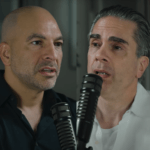In this “Ask Me Anything” (AMA) episode, Peter delves into the topic of high-intensity interval training (HIIT), starting with addressing some common misunderstandings around this type of exercise and breaking down what HIIT truly entails. He examines the correlation between HIIT and VO2 max, a vital metric for overall health and longevity, and describes the beneficial impact of HIIT on longevity when incorporated properly. Additionally, he emphasizes the importance of building a wide base of cardiovascular fitness, reveals the optimal protocols for incorporating HIIT into a balanced routine, and discusses the risk of injury and other potential drawbacks of HIIT.
If you’re not a subscriber and listening on a podcast player, you’ll only be able to hear a preview of the AMA. If you’re a subscriber, you can now listen to this full episode on your private RSS feed or on our website at the AMA #57 show notes page. If you are not a subscriber, you can learn more about the subscriber benefits here.
We discuss:
- Common questions about high-intensity interval training (HIIT) [1:30];
- The origins of HIIT [3:15];
- Defining HIIT training and differentiating it from sprint interval training (SIT) [5:45];
- Why HIIT is often touted as a more efficient way to exercise [14:00];
- Navigating the nuances of HIIT research: understanding limitations and the importance of a blended exercise routine [20:30];
- The four pillars of exercise [24:15];
- Using HIIT to improve VO2 max [26:00];
- HIIT training for the untrained individual: impact on VO2 max and the interplay between exercise-induced adaptations and potential weight loss [33:00];
- Sprint interval training (SIT) vs. HIIT: comparing the relative improvements in VO2 max and the impact of longer duration intervals [40:00];
- Benefits and limitations of HIIT, drawbacks of overtraining with HIIT, and the importance of a diversified routine to increase total cardiorespiratory capacity [44:15];
- HIIT protocols Peter recommends [58:45];
- The risk of injury and other potential drawbacks of HIIT [1:02:15];
- The importance of incorporating a balance of continuous moderate-intensity cardio and HIIT when aiming for longevity [1:04:00]; and
- More.
Common questions about high-intensity interval training (HIIT) [1:30]
Today’s episode is going to be exercise-related, but on a topic that we get asked about a lot and we haven’t really covered, which is HIIT, or high-intensity interval training.
It’s something that people see everywhere, it’s marketed a lot, people talk about it, and so we see a lot of questions come through around people who are wondering more about it.
- What are the different types?
- How does interval training fit in?
- Where can it be used?
- Where is it limited?
- What’s the “best” protocol?
- We’ll also hopefully talk a lot about how someone can increase their VO2 max (which has a lot of importance for people who are thinking about their longevity)
- We’ll also talk about the importance of having a broad exercise program and training, and not just specifically focusing on one thing
Anything you want to add before we hit the first question?
- Peter says that this was a subject matter that he had been kicking down the road a little bit because he couldn’t wrap his head around the right way to present it
- But he feels like it has finally sort of come together in the last couple of weeks
- He’s glad they waited until they had the data and the right studies to look at
- And then, obviously, the implications so that we make this much more rooted in:
- What do you need to do?
- As opposed to making sure you understand every molecular pathway of HIIT.
The origins of HIIT [3:15]
HIIT is such a commonly used word when people talk about exercise. Can you maybe set the stage of where it even comes from?
- There is some documentation from as far back as the 1800s of athletes who would use a combination of running and walking for their training (runners or long-distance walkers)
- What it comes down to is some documentation of athletes having altered their tempo between running and walking for their training
- It wouldn’t really be until kind of the early 1900s that it would be codified more seriously
- You would originally go back to the Finnish Olympic runners that first employed this type of training
- The term FARTLEK, coined in the 1930s, is derived from the Swedish language which may translate to something like “speed play”
- When Peter was growing up, they referred to alternating between fast and slow as “speed play”
Tabata
- Another familiar term is Tabata training
- A Tabata interval is a very specific type of interval
- This was first described in the 1990s where a guy by the name of Izumi Tabata who was the first author on a paper that first presented this
- Interestingly, though, the protocol seems to have been developed by Olympic speed skating coach Koichi Irisawa
- The interval was eight sets of 20 seconds on a bike, all-out interval with 10 seconds of rest, so you’re 20 seconds on, 10 seconds off, eight times, which gives you a four-minute duration
Defining HIIT training and differentiating it from sprint interval training (SIT) [5:45]
A lot of different programs, classes, gyms that call themselves HIIT training
Can you speak a little bit about what HIIT training actually is, and is there a way for people listening or watching to be able to differentiate between the different types or forms that they may see out there?
- HIIT definitely has a bit of a brand issue, says Peter
- Part of the problem with everything we’re about to discuss today stems from the fact that there’s no uniform definition in what constitutes HIIT
- Peter suggests that we be a little bit more specific and we differentiate between, for example, high-intensity interval training, or HIIT, versus sprint interval training, or SIT, or things like Tabata training (which kind of are a bit of a subset of SIT)
- The reason for that is they produce very different metabolic effects, they’re carried out at very different intensities, and by extension, they have different pros and cons
{end of show notes preview}






Random observation: among my cycling friends, there’s always some passive competitiveness with our respective estimated VO2 max values (as provided by our Garmin bike computers). I recognize this is childish and irrelevant, but it is also inevitable and wonderful trash talking fodder.
I’ve noticed over the years that my values tends to peak in late spring. I do train year round, but I inevitably train more in the warmer months (we’re in flyover country in the mid-west and the cold months force many of us indoors..). I would have expected my max values to come at the end of the summer after I’ve knocked out a lot more training (and 100+ mile gravel races). I suspect the Garmin value is an estimate based on effort (power) vs. level of effort (HR). My hypothesis is that our actual VO2 max values may be leveling off, but not decreasing. And, the late summer lower estimates are a function of higher heart rates due to warm/hot weather in the summer.
I could be wrong (maybe my winter efforts include more efficient HIIT type workouts)? Either way, the way most people “measure” their VO2 max could affect the way they interpret their results (as those tests/estimates may not consider all material variables).
Really enjoy your content. Thanks!
This really cleared up a lot of questions I had following Rhonda Patrick’s recent video on high intensity training. Thanks for referencing the biological mechanism. I feel there is a disconnect with how fun, high intensity training is, which is represented clearly in the popularity over the recent years 2010-2024. A clock is set and everybody races as a group where you reach your limit of intensity, four or five times and you have to stop and breathe for 10 or 20 seconds in order to continue, the race that everybody is in in classes, such as crossfit. Interestingly, the best study you referenced included a 40 minute time trial. time trials seem to have an integral effect for hit if you are inexperienced in pacing. Additionally, every time trial ends with a final minute or two, where you push yourself as hard as you can for the finish line most people don’t continue their pace at the finish line. At HIIT programs you just arrive at a community and everything is on the board it’s almost the opposite of being very scientific in how easy it is to just jump in with a group pushing themselves racing each other makes it very accessible and way that this AMA doesn’t seem to fully grasp in the dialogue about how painful it is. It is easy to attend 3 of these classes a week. Simply setting a clock and racing is an interesting integral when it involves non cardio friendly weights a rest is integrated without a formal plan. Some people may work out without any breaks while others may continuously encounter times when they have to stop and have reached their peak limits. I took a lot of notes and enjoyed this episode. Thank you.
I’m a fit 71 year old who has been doing aerobic exercise and weight training for years. About a year ago I had a CAC test and it came back with a score of 389. I’ve asked my cardiologist if it was okay for me to do strenuous exercise to increase my VO2Max and he didn’t see why I would even want to do that. His advice was to stick to no more than 80% of my predicted maximum heart rate even though I have measured my max heart rate at 174 bps. I would have loved to have submitted a question about whether high intensity / interval training is okay for fit individuals with moderate CAC scores.
I’m a 70-year-old in a similar boat (cycling, swimming, weights), except my CAC was 1982. (Not the year; that was my score.) So, I did a stress test to max HR with echo with no anomalies or issues. Then, I had a CT Angiogram done, with defined narrowing identified. All plaques were labeled ‘hard,’ with no soft plaque.
My cardiologist said it was ok to push myself and occasionally to a max HR (I do it weekly). He said to notify him if I feel something different – i.e., a noticeable decline in performance or feeling not explained by lack of sleep or other externality.
So I think there might be more avenues you could chase… stress test, CTA, and a new cardiologist who deals with aging athletes. Most cardiologists are Medicine 2.0, dealing primarily with sick people who have a hard time walking from the waiting to the exam room. The advice he gave you fits with that population.
Thanks for sharing your story. I agree that I need a different cardiologist. Now I just have to figure out how to find one that either isn’t a medicine 2.0 Doctor or at least values exercise in their patients and is open to hearing their concerns.
I would love to see a “registry” of Doctors who embrace the principles that Attia lays out for Medicine 3.0. Indeed I would pay for access to such a list.
I’m a 90 yr old cyclist who has done centuries in the past and loved ”the bike”. My bike is now on a trainer in the bedroom. Im using a heart moniter and
I’m 75 years old. I was a former basketball player in college and have maintained my fitness as of today. In the winter I lift weights and do mostly HIIT but I
walk quite often in zone 2 During the summer I walk the golf course about 3 times per week and swim and perform water strength training.
Is this too much considering my age? Should I focus on One type of exercise or continue with what I’m doing? (My resting HR is in the high sixties….BP about 110/60…normal weight..normal stress test except for L fascicular block
I feel that this discussion completely missed the core of what HIIT is and why it is appealing as an efficient form of exercise: that it is the combination of anaerobic interval training with muscle endurance training. Peter is only talking about the anaerobic side of it because he is focused on cycling, swimming and running. But for most people HIIT is about circuit training with bodyweight or weights for muscle endurance. ‘Muscle endurance’ is a key pillar in Andy Galpin’s fitness framework in addition to Strength, but it seems to be left out of Peter’s four pillars. So I hoped that this discussion was going to be about whether muscle endurance is important for longevity or not, and if so, whether HIIT is an efficient way to promote it and Anaerobic fitness at the same time. Maybe this can be covered in a future AMA?
I have had a similar “I love HIIT reaction ” because I like to feel the competition of a skill based race of variety – opposite of monotonous (for time, total circuit reps, chipper) the rush of a group going high intensity (even if its revving hard on a fan bike interval) , needing to stop because I just cant do another rep or I can’t breathe and how exercise itself can take on the quality of a sport. This popular intense exercise is painful and you reach your limit and learn how to pace yourself amidst an endless pallet of variety of exercise set up by a coach (pacing challenge puzzles daily). This blending would lend itself to the artistry of fun programming! This blend is hinted at early in the AMA. I don’t take competition too seriously (contributing to safety) but I can have fun pushing myself at a high intensity safely with a fitness community driven by the suggestion of competition with myself. HIIT is fun and maybe dangerous but danger fun and competition are somehow linked. I think we are just facing the fact that an old age long life program can’t be quite as fun as a competitive adrenaline filled acrobatic action movie adrenaline HIIT exercise program. I would prefer an acknowledgment of HIITs fun and popularity with advice on how to do it safely long term – the pain or rush of intensity is a bit too fun how do I remind myself that I can back off? I am curious to understand more about the balancing of our nervous system parasympathetic zone two and sympathetic HIIT – do they really balance each other?
would things that ended up on the outlive cutting room floor be available to members? could provide some interesting information people would be interested in, even if the publishers were not.